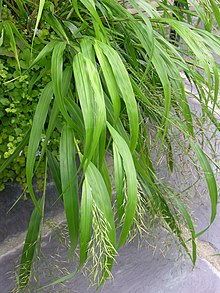| Hakonechloa | |
|---|---|

| |
| Hakonechloa macra 'All Gold' | |
| Scientific classification | |
| Kingdom: | Plantae |
| Clade: | Tracheophytes |
| Clade: | Angiosperms |
| Clade: | Monocots |
| Clade: | Commelinids |
| Order: | Poales |
| Family: | Poaceae |
| Subfamily: | Arundinoideae |
| Tribe: | Molinieae |
| Subtribe: | Moliniinae |
| Genus: | Hakonechloa Makino ex Honda |
| Species: | H. macra
|
| Binomial name | |
| Hakonechloa macra (Makino) Honda
| |
| Synonyms[1] | |
| |
Hakonechloa is a genus of bunchgrass in the tribe Molinieae of the grass family, Poaceae, native to eastern Asia.
Hakonechloa macra, with the common names Hakone grass and Japanese forest grass, is the only species in the monotypic genus. It is endemic to Japan.[1][2][3]
Hakonechloa macra is a small, mostly shade-loving, clump-forming bunchgrass, slowly spreading in circumference. The stalks cascade in a graceful rounded fountain shape somewhat reminiscent of Pennisetum (fountain grass) but with the actual leaves resembling Chasmanthium. The species tends to be between 45 cm and 60 cm (18" to 24") in height.
The leaves are thin and papery and resemble many forms of bamboo. They are very flexible and have a distinctive rustling sound when the wind blows that adds to their appeal. The foliage rises from the roots on thin wiry stalks. The leaf blades are green but many color variations exist. The papery texture keeps the foliage cool to the touch and often the surface is slightly puckered or rippled.
The flowers bloom in midsummer from leaf nodes near the ends of the stalks. The flowers are light purple fading to tan then dropping off over the course of several weeks.
Hakonechloa macra is grown as an ornamental plant, for use in gardens and as a potted plant. The various cultivars of Hakonechloa macra are used as foliage plants in gardens in temperate climates. The species[4] and the cultivars ‘Alboaurea’[5] and ‘Aureola’[6] have gained the Royal Horticultural Society’s Award of Garden Merit.[7]
The cultivars of Hakonechloa macra may be green, or boldly variegated in stripes of white, green, or yellow, or have solid colored leaves. Some cultivars tend to turn orange or red in colder weather. The cultivars often grow significantly shorter in height than the species. The height may also be somewhat dependent on soil moisture, nutrients, and length of growing season. The plant is tough enough to survive in USDA Zone 5, −28 °C (−18 °F). It prefers even moisture and average humidity, but can tolerate minor dry spells and arid climates (with irrigation) with minimal damage.
It is mainly used as an ornamental grass in Japanese style gardens, or to brighten shady areas of the garden. The graceful form tends to soften formal shady areas as well. Solid green leaves are the hallmark of the species. The green form is the fastest grower and tends to be slightly larger than most cultivars, and is mildly sun tolerant though it may burn if not given adequate shade. The foliage tends to be deep bright green and may have orange, red or purple tones to some degree in the fall.[8]
Solid foliage color variations include:[9]
Variegated foliage color variations include:[11]
Hakonechloa macra can be easily propagated by division. The rootball has many stalks coming up from a dense rhizomatous cluster of roots. Apparent on the rhizome are small buds that look like thorns. These are new shoots and with care they can be removed from the root cluster with a small segment of rhizome taking care to include connected roots.
When planted and properly cared for, the grass will root and spread to form a clonal selection of the grass. Horticultural tissue culture may also be utilized by propagators with the appropriate equipment.
Hakonechloa: Derived from Japanese and Greek, meaning ‘Hakone grass’. Named for the Hakone hot springs region near Mount Hakone in Honshu, Japan.[13] Macra: Derived from Greek, meaning ‘big’, ‘large, ‘long’, ‘deep’, ‘tall’, or ‘far’.[13]